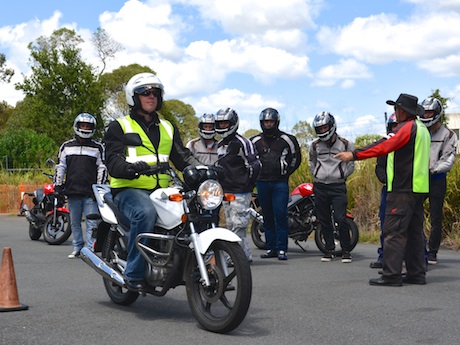“A lot of people forget how hard it is to ride; how many things there are to learn,” says Honda Australian Rider Training (HART) instructor Calum Finlayson as I observe him train a group of learner riders. He’s right. In just a few short drills, I realise just how much of my riding I take for granted, also how many bad habits I’ve adopted and just how difficult it really is for learner riders to put so many parts of the jigsaw puzzle together and ride smoothly and safely.
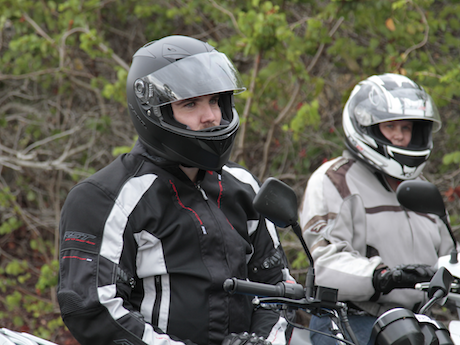
After all, it’s not easy. Clutch on the left hand, front brakes with the right hand, gears on the left foot, rear brake with the right foot, left thumb for indicators and horn, right hand for acceleration and all while trying to balance a two-wheeled machine that is probably twice as heavy as you. When you put it like that and witness learners struggling with even the most basic skills such as slalom or figure eights, you realise that riding a bike is not as easy as falling off a bike!
Over a two-day HART course, I follow the progress of learner rider Mitch Hamrey, 23, who has only ridden dirt bikes around farm paddocks before this. On day one he’s both nervous and excited, just like all the others.
HART is the biggest motorcycle rider training organisation in Australia. National HART Manager Mark Collins says they train almost 20,000 riders and young drivers a year, from five purpose-built training venues in Melbourne, Sydney and Brisbane with about 40 instructors on the east coast, one in Adelaide and one in Perth. “Only two of these instructors have less than two years’ experience,” he says. Calum, who has 25 years of riding experience and has been instructing at HART for two years, says they have to talk differently to each rider, according to their confidence levels. “It’s intimidating for learners when they walk through the door,” he says.
“The secret is to add skills gradually,” he says. “We start by just going forward six inches at a time with both feet on the ground. Three hours later they are changing gears, using the brakes, turning corners, riding slowly, doing slaloms and riding figure eights.”
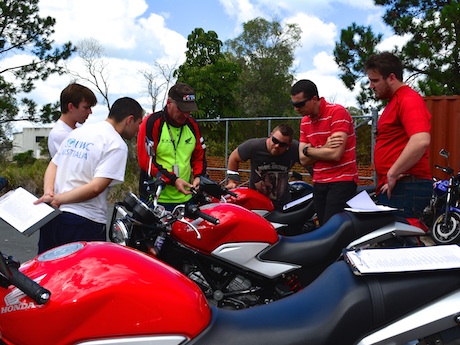
Mitch says the feedback from the instructors is constructive and never negative which gives him confidence to tackle new skills. “As all of the instructors who have been riding for a multitude of years told us ‘We still learn new things about motorbikes and riding motorbikes all the time. If we knew everything we would be MotoGP champions but we aren’t’.”
On this day, Calum’s fellow instructor is Doug Doyle who has more than 50 years of riding experience and has been with HART for six-and-a-half years. “They are all nervous when they first arrive, but then it’s fun,” he says and you can see the delight on the faces of the riders when they start to put a couple of skills together.
Their joy is infectious. I just want to hop on my bike right now and relish the pure joy of letting out the clutch and puling away from the kerb. Such a simple thing that we take for granted; the ability to hop on a bike and make it do what you want to do without having to concentrate on all the little things. And you can see in the eyes of the learner riders that they are starting to understand the many years of boundless joy that lie ahead of them. But right now it’s back to the basics.
Learner riders sit through a frustrating classroom briefing first before getting up close and personal with their bike. For this course, learner riders are given either a CB125 or a VT250, both lightweight and predictable city machines. Mitch says the bikes are well-maintained, small and agile which pumps up his confidence. “The bike never felt too big and bulky to manoeuvre about the range and had enough power to get going when we finally pulled out for the road ride,” he says.
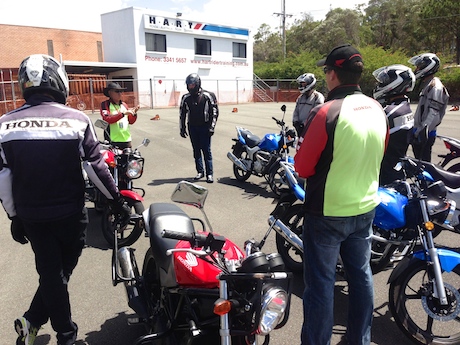
Still, it’s a hurdle to first throw your leg over a machine that is pulsating between your legs and then lift your feet and trust it to go where it’s pointed. “Getting people over the initial feeling of using the throttle and making them comfortable depends on the way you talk to them,” says Doug. “You can’t force it on them. You have to talk to people differently. Some people are comfortable and you can see how quickly they get through it, but others are more nervous and you have to coax them.” He says they have two instructors so one can pick up the slower learners and spend more time with them to bring them up to the ability of the other riders.
On this course, the learners are all young males and fairly even in ability. There is a bit of testosterone talking among some, but their evident lack of skills brings the realisation that they might be talking beyond their means and they soon come back town to earth when they fail a simple drill. Mitch is more quiet and reserved than the others and progresses quickly through the skills. Doug says males can be ego and testosterone driven, while women can sometimes be easier to teach. “Women listen better, but they are more cautious so it is harder to get them to use the throttle,” he says. “They tend to take off more slowly and that’s a problem because revs are important. You get more stability when you are moving. However, you can’t generalise; guys can be cautious too.”
After the instructors have them moving, it’s time to add one skill at a time. Next is braking, then it’s changing gears, then it’s corners, then it’s slalom and pretty soon, the riders are going around the course, marvelling at how much they have learnt in such a short space of time. It’s only day one, but they are high-fiving and back-slapping each other, determined to come back for the second day and secure their licence. In Queensland, it’s a competency-based licensing scheme where the instructors observe riders over six competencies and then on a road ride.
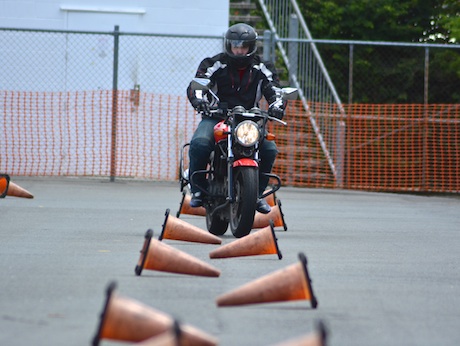
Calum believes it is a better system than the adversorial test used in some other states. He says HART has a 90% success rate among learners simply because of the system of observing, rather than testing. Mitch says that at the start of the first day there may have been one or two riders out of the seven that were looking at buying a motorbike in the near future. “At the start of the second day almost all of the riders had been surfing the web the night before and had started compiling their wishlists of bikes and had started planning to buy a bike. Some had even been out to buy jackets, helmets and gloves,” says Mitch who had eagerly bought his riding gear a month earlier.
The next day the “L’s Angels” as they are now calling themselves, return to the Slacks Creek centre for more course training, a road craft classroom session and then the testing. First come the six competencies: slow riding, slalom, controlled stop, emergency stop, figure eight and hazard avoidance. It’s high pressure and high stakes, but the instructors keep their cool and encourage the riders to do the same. They have to complete each competency at least three out of five times. For example, the 18m slow ride course has to be completed in more than 10 seconds, while the seven-changes-of-direction slalom has to be done in under eight seconds. Testers have a stopwatch and time is ticking away for the riders.
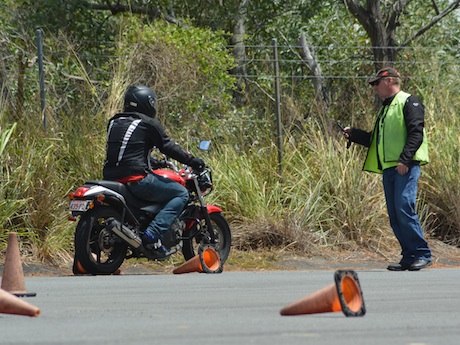
The instructors hand out tips and encouragement and pretty soon all learners have completed their three passes, only a few requiring a fourth attempt. “The most difficult thing that almost everyone struggled with was slow riding and the figure 8,” says Mitch. “For something that looked so simple the first few goes were a real struggle. The tips and coaching that the instructors gave made us all look like we had been delivering mail on a postie-bike for years as we all passed the figure 8 assessment first go.”
Then it’s out on to the road to observe how they control their bike, their use of the road, their observation skills and their maintenance of a safety bubble from hazards and other traffic. The route takes in suburbs, busy shopping areas and highway. “The build-up to the road ride was a bit nerve-racking as you were run through all the road rules, dos and don’ts and many potential dangers on the road.
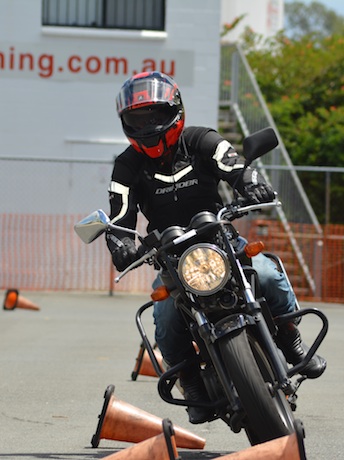
After a day and half doing laps of a carpark where you were relatively safe it was a big step up to pull out on to the road with the traffic, lanes, stop signs, traffic lights and hills adding a whole new element to riding,” says Mitch. “The feeling of pulling out on to the highway and winding the bike up to 100km/h was an exhilarating moment. The gang of “L’s Angels” all clad in hi-vis vests were definitely eye catching in the traffic and made everyone pay attention.”
Doug says they relate their road craft lessons to what people do in their car. “Then we remind them that they are not in a steel cage, but on a bike and are doing things totally differently and their risk level is higher, so they become more aware of their surroundings,” he says.
A couple of extra riders are here for the Sunday lesson, confident enough in their riding skills that they just need a quick practice session before doing the observed test. However, it may be false confidence, judging by how markedly lower-skilled they are than the riders who attended the Saturday session. One has been boasting about his skills, then drops the bike when asked to push it 10m. Calum confirms that they have a higher success rate among those who do the two days, rather than just one. The two lads who have arrive for the one-day session have quickly quietened down when they realise their skills are not as good as they thought.
Mitch says the course isn’t focused on passing or failing the test. “It is heavily focused on you as a rider becoming competent and safe and educating you on your vulnerability as a rider and how you can best manage the possible risks that you face each time you hop on the bike.”
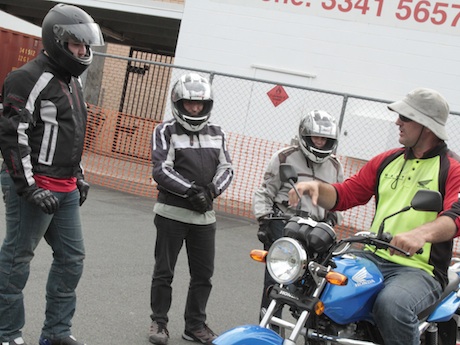
Today everyone passes, but Doug and Calum admit that is not always the case. Calum says those who fail are usually very aware of what they have done wrong. Doug says it can sometimes end in tears. “One in 5000 might end in tears, but usually they are just mad at themselves for doing something stupid in the observation and not getting their licence.” For those riders today who have all passed, the feeling isn’t one of relief, but elation at the thought of joining one of the most exciting and liberating recreational pastimes.
Mitch also recommends a one-day pre-learner course for those who are not certain they want to get a licence or that riding is for them. “If you’re not that confident starting out on the two-day course, the pre-learner course is a great informal three hours just getting used to the bike and gives you a taste of what to expect and makes you even keener to take the next step up to the two-day course.” He was joined on that course by 40-somethings Simon and Michelle Sammut who hadn’t ridden since they were in uni. “I’m not sure I’m ready to rush out and buy a motorbike just yet, but it’s always there and I’m glad I did the course with my wife. She loved it too,” Simon says.
Just observing the pre-learner course and two-day licence course, I’ve also ridden away with more knowledge and skills … and maybe fewer bad habits!


